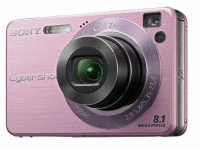
New York Times has posted a review of the Sony A300 with plenty of praise for Sony’s breakthrough Live View feature.
The camera focuses quickly as you aim the lens, without ever blacking out the screen. When you press the shutter, the screen doesn’t go on-off-on, there’s no loud clacking, and there’s no baffling exhibition of mirror calisthenics inside the camera.
For the latest news and reviews, check out Photography Bay’s Sony A300 page.



 The Sony DSC-W130 is a 8.1-megapixel compact point and shoot digicam with a 4x optical zoom and 2.5 inch LCD screen. The Sony W120 features a number of powerful features, including: Sony’s D-Range Optimizer to retrieve picture detail in photos with harsh highlights or dark shadows; semi-manual focus that allows you to select the focusing distance based on your subject’s location; an improved auto focus system that includes macro ranges; Super SteadyShot image stabilization; high sensitivity settings up to ISO 3200; and in-camera editing functions such as “unsharp mask” to sharpen images.
The Sony DSC-W130 is a 8.1-megapixel compact point and shoot digicam with a 4x optical zoom and 2.5 inch LCD screen. The Sony W120 features a number of powerful features, including: Sony’s D-Range Optimizer to retrieve picture detail in photos with harsh highlights or dark shadows; semi-manual focus that allows you to select the focusing distance based on your subject’s location; an improved auto focus system that includes macro ranges; Super SteadyShot image stabilization; high sensitivity settings up to ISO 3200; and in-camera editing functions such as “unsharp mask” to sharpen images.







